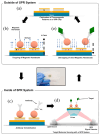Surface Plasmon Resonance-Based Biodetection Systems: Principles, Progress and Applications-A Comprehensive Review
- PMID: 39852086
- PMCID: PMC11763797
- DOI: 10.3390/bios15010035
Surface Plasmon Resonance-Based Biodetection Systems: Principles, Progress and Applications-A Comprehensive Review
Abstract
Surface Plasmon Resonance (SPR)-based biodetection systems have emerged as powerful tools for real-time, label-free biomolecular interaction analysis, revolutionizing fields such as diagnostics, drug discovery, and environmental monitoring. This review highlights the foundational principles of SPR, focusing on the interplay of evanescent waves and surface plasmons that underpin its high sensitivity and specificity. Recent advancements in SPR technology, including enhancements in sensor chip materials, integration with nanostructures, and coupling with complementary detection techniques, are discussed to showcase their role in improving analytical performance. The paper also explores diverse applications of SPR biodetection systems, ranging from pathogen detection and cancer biomarker identification to food safety monitoring and environmental toxin analysis. By providing a comprehensive overview of technological progress and emerging trends, this review underscores the transformative potential of SPR-based biodetection systems in addressing critical scientific and societal challenges. Future directions and challenges, including miniaturization, cost reduction, and expanding multiplexing capabilities, are also presented to guide ongoing research and development in this rapidly evolving field.
Keywords: Surface Plasmon Resonance; biodetection systems; drug delivery; environmental monitoring; food safety; plasmonics.
Conflict of interest statement
The authors declare no conflicts of interest.
Figures














Similar articles
-
Principles and Applications of ZnO Nanomaterials in Optical Biosensors and ZnO Nanomaterial-Enhanced Biodetection.Biosensors (Basel). 2024 Oct 6;14(10):480. doi: 10.3390/bios14100480. Biosensors (Basel). 2024. PMID: 39451693 Free PMC article. Review.
-
Present and future of surface plasmon resonance biosensors.Anal Bioanal Chem. 2003 Oct;377(3):528-39. doi: 10.1007/s00216-003-2101-0. Epub 2003 Jul 19. Anal Bioanal Chem. 2003. PMID: 12879189 Review.
-
Advancements in SPR biosensing technology: An overview of recent trends in smart layers design, multiplexing concepts, continuous monitoring and in vivo sensing.Anal Chim Acta. 2020 Apr 1;1104:10-27. doi: 10.1016/j.aca.2019.12.067. Epub 2019 Dec 27. Anal Chim Acta. 2020. PMID: 32106939 Review.
-
Surface plasmonic biosensors: principles, designs and applications.Analyst. 2023 Dec 4;148(24):6146-6160. doi: 10.1039/d3an01241g. Analyst. 2023. PMID: 37921208 Review.
-
Plasmonic Biosensors for Health Monitoring: Inflammation Biomarker Detection.ACS Sens. 2025 Feb 28;10(2):577-601. doi: 10.1021/acssensors.4c03562. Epub 2025 Feb 7. ACS Sens. 2025. PMID: 39917878 Review.
Cited by
-
Plasmonic Biosensors in Cancer-Associated miRNA Detection.Biosensors (Basel). 2025 Mar 4;15(3):165. doi: 10.3390/bios15030165. Biosensors (Basel). 2025. PMID: 40136963 Free PMC article. Review.
-
Graphene-Based Plasmonic Antenna for Advancing Nano-Scale Sensors.Nanomaterials (Basel). 2025 Jun 18;15(12):943. doi: 10.3390/nano15120943. Nanomaterials (Basel). 2025. PMID: 40559306 Free PMC article. Review.
-
Surface Plasmon Resonance Aptasensors: Emerging Design and Deployment Landscape.Biosensors (Basel). 2025 Jun 4;15(6):359. doi: 10.3390/bios15060359. Biosensors (Basel). 2025. PMID: 40558441 Free PMC article. Review.
-
Plasmonic Nanostructures for Exosome Biosensing: Enabling High-Sensitivity Diagnostics.Nanomaterials (Basel). 2025 Jul 25;15(15):1153. doi: 10.3390/nano15151153. Nanomaterials (Basel). 2025. PMID: 40801693 Free PMC article. Review.
-
Integrated Photonic Biosensors: Enabling Next-Generation Lab-on-a-Chip Platforms.Nanomaterials (Basel). 2025 May 13;15(10):731. doi: 10.3390/nano15100731. Nanomaterials (Basel). 2025. PMID: 40423121 Free PMC article. Review.
References
-
- Divya J., Selvendran S., Raja A.S., Sivasubramanian A. Surface Plasmon Based Plasmonic Sensors: A Review on Their Past, Present and Future. Biosens. Bioelectron. X. 2022;11:100175. doi: 10.1016/j.biosx.2022.100175. - DOI
-
- Butt M.A., Khonina S.N., Kazanskiy N.L. Plasmonics: A Necessity in the Field of Sensing-A Review (Invited) Fiber Integr. Opt. 2021;40:14–47. doi: 10.1080/01468030.2021.1902590. - DOI
Publication types
MeSH terms
LinkOut - more resources
Full Text Sources

